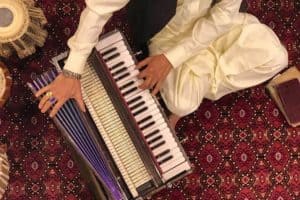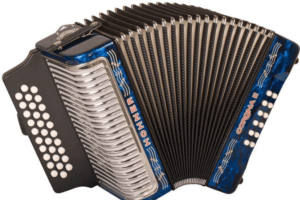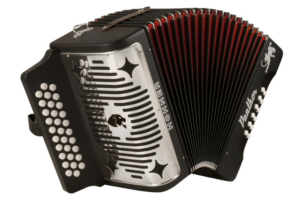The accordion is one of the most iconic and most unique musical instruments. Otherwise called squeezeboxes, these instruments are box-shaped and are powered by bellows to produce sound. Musicians use accordions in a variety of musical genres. Despite their popularity, many wonder how accordions work.
How do accordions work? Accordions are bellow-driven instruments with buttons, and for piano accordions, piano keys. When pressing a key or button, while compressing and expanding the bellows, metal plates blocking the corresponding free-reeds open. When the plates open, air passes through the free-reeds, causing them to vibrate and produce sound. An accordion can have up to six reed blocks of varying octaves.
Accordions are very popular worldwide. Musicians in Latin America, including Brazil, Panama, Colombia, and Mexico use it for popular music. In Europe and North America, the accordion is used for folk, jazz, and cajun music. In San Francisco, California, they named the accordion as their official city instrument.
Despite the popularity of accordions, some may not know how they work and how they produce sound. To be fair, these instruments are a bit more complicated than many other musical instruments.
Read on to learn more about how accordions work, including the different parts of the accordion and the different types of accordions.
Also, we hope you find the links here useful. We may get a commission if you purchase something through a link on this page, so thank you!
Also, for an excellent button accordion, take a look at our top pick, the Hohner 3100GB Panther Diatonic Button Accordion in Black with accordion case and cloth:
Click here to see it on Amazon.
Parts of an Accordion
There are many types of accordions, and each one of them has different parts and structures. However, there are some universal components that you can find in any accordion. To understand how accordions work as a whole, one must first understand the different parts of the accordion and how the parts work.
1. Reeds
Accordions produce sound through the use of free-reeds. These reeds can be found inside the casings of the accordion. The casing is the boxy part of the accordion that has buttons or keys attached to it. The casings can be found on either side of the accordion. Within the casing of the accordion, you can find reed blocks. There can be up to six reed blocks inside an accordion.
Reed blocks are made up of wood or metal. Each reed block in the treble casing has a series of reeds covered by valves. Reeds are made up of steel and brass, while the valves are leather. The treble casing is the side with piano keys (for piano accordions), often found on the right side of the accordion. The ends of the reed blocks taper from large to narrow, forming a harmonica-like structure. At the opposite side of the accordion lies the bass casing or the bass machine. Like the treble casing, it also uses reed blocks to produce sound.
Using both the treble and bass sides of the accordion, you can play both the chords and the melody at the same time. This makes the accordion a very versatile musical instrument. An accordionist is like a one-man band.
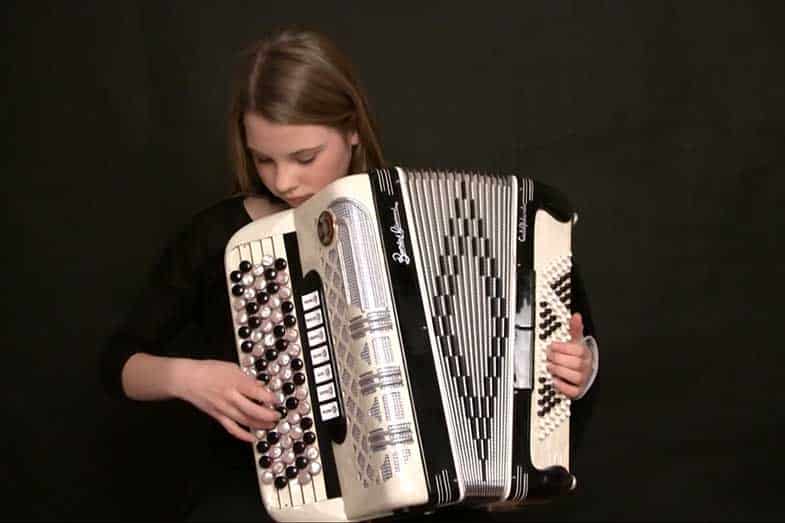
2. Bellows
The bellows are the most noticeable part of an accordion. Bellows are usually made of pleated cardboard and cloth, reinforced with leather and metal. The bellows can be found in the middle, connecting the treble and bass casing. Compressing the bellows creates air pressure, while expanding it creates a vacuum. In both cases, air passes through the free-reeds causing it to vibrate, which in turn produces sound.
Much like a violin’s bow, the bellows are the main tool for articulation. They are the “lungs” of the accordion. They determine how each note sounds, including the length of the sound, the control, and the fade. For example, the forceful and rapid use of the bellows will produce loud sounds, while slow and smooth bellowing will produce softer sounds.
3. Switches
Accordions also come with a switch located on either side of the bellows of the instrument. Clicking each of these switches makes it possible to change the accordion’s “voice.” With switches, you can fully control the timbre and the sound quality of the notes. Each switch connects to a single reed block. The more reed blocks an accordion has, the more switches it has. How do these switches work? Each reed block inside the accordion has different octaves or registers.
Clicking a switch opens a reed block, making it possible to play that particular octave. With the use of the switches, a musician can mix and match different reed blocks with varying octaves and registers to produce various sounds. For example, one can simultaneously play the lowest and the highest timbre or octave. By doing so, they can produce sounds unique and different from playing just a single octave.
Some accordions have blocks that are similar in tuning. Their differences are minimal but when played together, produce a unique sound effect. When played together using switches, it produces unique vibrations on the timbre known as the tremolo effect. French music uses this kind of effect. Mexican, German, Irish, and Italian folk music also uses this effect.
4. Keys and Buttons
As mentioned above, the reed blocks connect to a set of piano keys on the treble side and buttons on the bass side. While the majority of accordions use both piano keys and buttons, some types of accordions only have bass buttons. For these types of accordions, both sides only have buttons.
For the treble side, when pressing a piano key, the valves covering the reeds open. When they open, flowing air from the bellows can pass through the reeds. This causes the reeds to vibrate, and the vibration produces the sound. As for the bass side, instead of valves, it uses a set of levers and rods attached to the buttons to play the reeds.
In most accordions, a special key called the air button is present. Pressing the air button lets you move the bellows without making any sound. Since compressing and expanding the bellows produces a different sound, the air button can be useful to control the sound you want to play.
The piano key side of an accordion is very visible while playing the instrument. Unlike the keys, the buttons are not visible from the musicians’ view. As an accordionist, one must be able to memorize the buttons. True, there are tactile clues for the buttons, but this can still prove to be a challenge for beginners.
5. Bass Button Placement
Most accordions follow the Stradella Bass System. Also called the standard bass system, the layout features columns of buttons arranged in a circle of fifths (C – G – D – A – E – B – F). The most common layout is 120 buttons arranged in 6 columns. Smaller accordions have lesser columns or rows, but the layout is still similar.
Starting from the nearest to the bellows, the following columns are:
- Major third above the root notes
- The Root notes
- The Major chords
- The Minor chords
- The Seventh chord
- The Diminished seventh chord
As you can notice, the first two columns are single notes. Meanwhile, starting from the third column, the buttons are chords. Some of the keys, like the root note C, often comes with a rhinestone, a bump, or a hole to help identify the button. Root notes A-flat and E also comes with markings or tactile clues.
Aside from the Stradella bass system, there are also free bass accordions. This type of button layout and structure is more popular in European countries than in the Americas. For free bass accordions, all the buttons are single notes. The buttons are chromatically arranged and range from four to five octaves. You can still play chords depending on the reach of your hand. Like the Stradella accordions, 120-button is also the most common layout.
Click here to see this Hohner 3500GR Corona II G/C/F Diatonic Accordion on Amazon.
How are Accordions Made?
Understanding how an accordion is made is beneficial. A simple knowledge of how accordions are made can also help understand how the instrument works.
It takes literally hundreds of parts to make an accordion. Wood is often the material of choice for the outer parts. This includes the frame, the reed blocks, and the pallets. Metals and hard plastics are the chosen materials for the inner parts. Clothes and cardboard, reinforced with leather and metal, are the way to go for bellows. Meanwhile, the keys, the buttons, and other outer movable parts are all plastic.
Assembling an accordion takes a lot of time. Some of the assembly processes may involve automated machines, but the majority of the parts are put together by hand.
How do accordions work? How are they made? See this great video, which goes into detail.
Making the Parts of the Accordion
The first step to manufacturing an accordion is to make the individual parts of the instrument. The creation process of these parts is automatic.
- For the wooden parts, machines precisely cut pieces into different shapes and forms. This process includes the creation of the casings, the reed boxes, and the frames of an accordion.
- For plastic parts, such as the buttons and the keys, a machine forcefully injects liquified plastic into molds to form the parts. After cooling, the molds open and inspected by the manufacturers.
- Metals melt into a liquid and placed into molds. After the metal cools, they undergo tampering to reduce the brittleness and hardness of the metal. Tampering the parts makes it durable and tough.
After the creation process, the individual parts are now ready for assembly.
- The metal reeds connect to a reed plate, often made up of aluminum. Manufacturers secure the reeds over each of the two opposite slots of a reed plate.
- The reed plates are arranged inside a wooden compartment called a reed block. There are two to four reed blocks placed inside the treble and bass sides. The buttons, the keyboard, along with the piano keys, placed to the reed blocks during assembly.
- After assembling both of the treble and bass sides, the next step is attaching the bellows. The bellows connect both the treble and the bass casings, often secured using wax. The bellows are also checked to see if there is no air leakage.
- After assembling the parts of the accordion, the last step is to add finishing touches. Manufacturers add custom designs and colors. Manufacturers also add their logo.
This is the process of making an accordion. There are various types of accordions, but this is the usual process of making one. In terms of types, two of the most common classification of accordions; piano accordions and button accordions. Which one is better?
Piano Accordion vs. Button Accordion
Piano accordions are accordions with piano keys on the treble side. Button accordions, on the other hand, have buttons on both the treble and bass sides. There’s an ongoing debate on which of these two is better. The truth is, it all depends on your preferences and playing style.
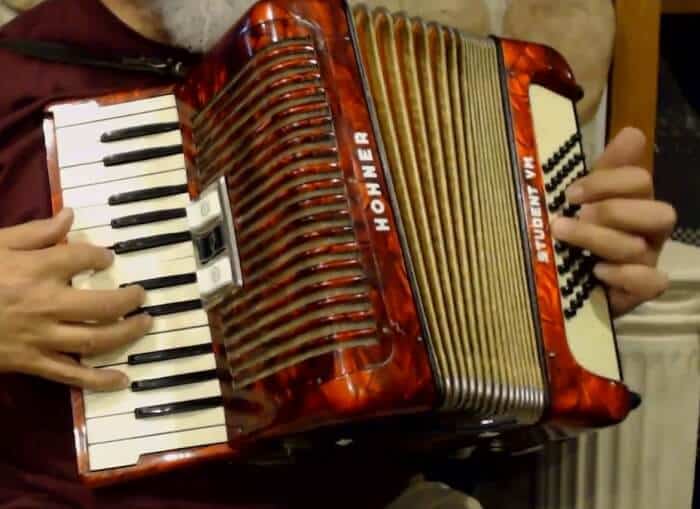
So what are the differences of a piano accordion and a button accordion? Here are some advantages of choosing a piano accordion over a button accordion:
- More common than buttoned accordions. As such, it’s easier to find teachers and guides on how to play them. This also makes it slightly easier to find a repair shop or spare parts for the accordion.
- The layout of the keys is logical and simpler than button accordions.
- Piano accordions are very similar to other keyboard instruments.
- All of the keys on a piano accordion are functional, unlike some dummy keys on a button accordion used for cosmetic reasons.
If you want a great beginner piano accordion, see the Hohner Accordions BR48R-N 26-Key Piano Accordion:
Click here to see it on Amazon.
Hohner is the leading manufacturer of high-quality accordions at an affordable price range. The BR48R-N Piano Accordion has 26 keys, Tremolo Tuning, range B-C, 2 treble registers, 48 bass buttons, and a great price. It is my go-to recommendation for anyone wanting to learn how to play the piano accordion.
Here are some advantages of choosing a Button accordion over a button accordion:
- Button accordions are usually more compact than piano accordions. It is also relatively easier to play distant notes on a button accordion, whereas on a piano accordion, one must practice precision in pressing the keys.
- Transposition is so much easier on a button accordion.
- As a beginner, it is easier to learn the button accordion due to the simplicity of the fingering patterns.
- Button accordions can have at most 64 notes at the right-hand side while a piano accordion only can have up to 45.
An excellent button accordion is the Hohner Panther G/C/F 3-Row Diatonic Accordion. This button accordion is another great value instrument from Hohner.
Click here to see it on Amazon.
It has 31 buttons, 12 bass buttons, and double strap brackets. It is a lightweight and great value accordion compared to more premium accordions. This is a great kit for beginners with included case and a cleaning cloth.
Ready to elevate your music game? Dive into our expert guide on the Best Accordions for Advanced Musicians! Uncover top-notch instruments that will fuel your passion and take your skills to new heights. Don’t miss out on this must-read for seasoned musicians in search of their dream accordion!
Conclusion – How Do Accordions Work?
Accordions are amazing and one of the most unique musical instruments. Despite what other people think, the process by which they produce sounds is rather simple.
How do accordions work? Accordions produce sound using the bellows and the button, and the keys. The buttons and keys connect to the reed blocks, a series of reeds that make up a harmonica-like structure. A leather valve covers each of the reeds. There can be multiple reed blocks with different octaves.
The bellows produce air inside the instrument when expanded and compressed. When pressing a button or key, the valve covering the reeds open. The flowing air passing through these reeds produces the sound.
Now that you know how accordions work, it’ll be easier to choose one if you want to start playing. The accordion may seem like an intimidating instrument for some, but it is fairly easy.
Related reading:
Best Accordion – Top 10 Button and Piano Accordions
Piano Accordion Vs Button Accordion – Key Differences
What Type of Accordion is Easier to Play: Button or Accordion?





![The Stratosphere Guitar Parts [Full Review] The Stratosphere Guitar Parts](https://musicalinstrumentpro.com/wp-content/uploads/2021/11/The-Stratosphere-Guitar-Parts-150x150.jpg)
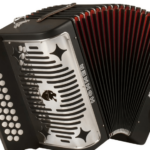
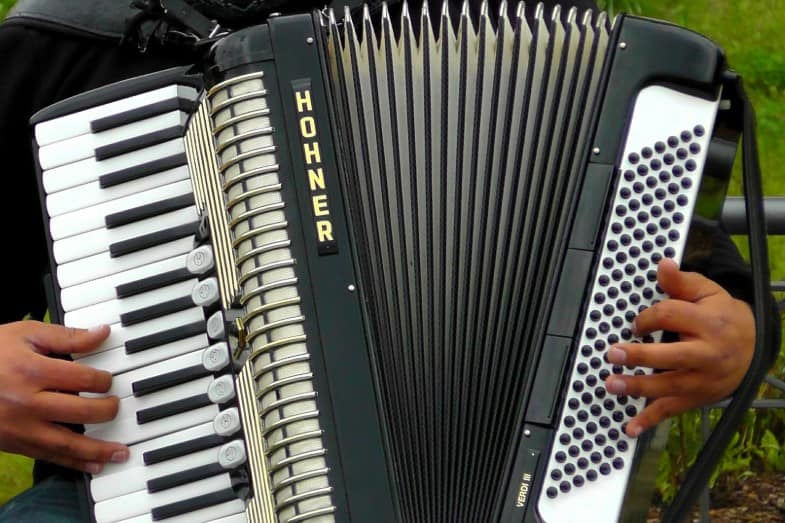

![Accordion-like Instruments [Full List] accordion like instruments](https://musicalinstrumentpro.com/wp-content/uploads/2022/09/accordion-like-instruments-150x150.jpg)
